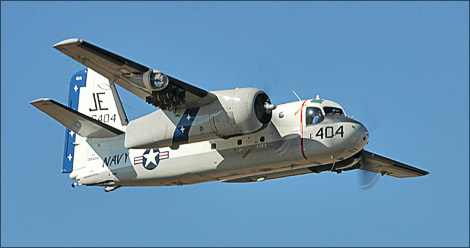|

Photo by Max Haynes -
MaxAir2Air.com.
History: In the late 1940s, the US Navy
decided it needed a new aircraft for its anti-submarine missions. Previously, the task had
been accomplished by teams of two airplanes, one performing the "hunter" role
with its radar, and the other acting as the torpedo-equipped "killer."
Logistical problems and advancing technology soon negated the advantages of these
two-aircraft attacks, and a single aircraft became the ideal. Grumman responded to this
need with a twin-engine, high-wing prototype called the G-89.
It featured a large payload capacity for sensors and weapons, a retractable search radar,
a magnetic anomaly detector (MAD) boom, searchlights, and other much-needed features.
Folding wings and a tailhook made it aircraft-carrier capable.
The prototype aircraft first flew on 4 December 1952, under
the US Navy designation XS2F-1. Three major variants appeared
almost immediately, and their designations were finalized in 1962 as the S-2
Tracker, the E-1 Tracer, and the C-1
Trader. The S-2A, the first production version of
the Tracker, entered anti-submarine service in February 154, and more than 500 were
delivered to the US Navy and several other nations. Several of these were delivered as
trainers and were called TS-2As.
Other variants included the S-2C
(enlarged weapons-bay, larger tail to compensate for higher gross weight); US-2A/B/C
(S-2s converted for utility use such as target towing and light transport); RS-2C
(photo-reconnaissance); S-2D (increased wing span, larger tail,
four-man crew in widened / lengthened fuselage, larger sonobouy payload); S-2E
(modified with more advanced search equipment); S-2F (S-2Bs
modified with this same equipment); CS-2F/CP-121
(deHavilland-built Trackers for the Royal Canadian Navy); and S-2G
(the final advanced version of the Tracker, which served into the 1970s.)
The C-1 Trader, meanwhile, was
delivered as a nine-seat transport for use as a Carrier On-board Delivery (COD) aircraft,
and the E-1 (WF-2) Tracer was equipped with a large overhead
radome containing a powerful APS-82 early-warning search radar. Even after the design was
replaced in the US Navy by the jet-powered S-3 Viking, it lives on in several
reincarnations. Taiwan purchased at least 32 S-2T Turbo Trackers,
which are Grumman-modified S-2s powered by Garrett TPE-331 turboprop engines. Also, the
S-2 has become a popular airplane for use as a firefighting water bomber, in the US and
elsewhere.
Finally, several S-2s and C-1s are privately owned and flown
as warbirds. They are well-loved for their toughness, reliability, and huge load-hauling
capability. (What better way to attend an airshow or fly-in than by taking along six or
eight friends and all the supplies you'd ever need?)
Nicknames: Stoof (S-2F variant); Stoof
with a Roof / Willie Fudd (WF-2/E-1 Tracer variant)
Specifications (S-2E):
Engines: Two 1,525-hp Wright R-1820-82WA Cyclone 9-cylinder radial piston engines.
Weight: Empty 18,750 lbs., Max
Takeoff 29,150 lbs.
Wing Span: 72ft. 7in.
Length: 43ft. 6in.
Height: 16ft. 7in.
Performance:
Maximum Speed at
Sea Level: 265 mph
Patrol Speed at
1,500 ft: 150 mph
Range: 1,300
miles
Armament:
One Mk 57 or Mk
101 nuclear depth bomb or similar in bomb bay.
60 depth charges
in fuselage
32 sonobuoys in
engine nacelles
Six underwing
hardpoints for bombs, rockets, or torpedoes.
Number Built: 1,181 Trackers/Traders
Number Still Airworthy: Approximately 10
flown as warbirds; Unknown number in active military service worldwide, and as
firebombers.
Links:
"Clark's S-2 Tracker Museum"
Conair, Abbotsford, BC, Canada -- S-2
firebomber conversions.
"The World's First Grumman
S-2 Tracker Website"
Tracker Air Group ("The Iron
Lady")
Trader Air -- Privately-owned C-1 Trader in
Kansas, USA

[Back to Warbird Alley's Main
Page]
All text and photos Copyright 2016 The
Doublestar Group, unless otherwise noted.
You may use this page for your own, non-commercial reference purposes only.
 |